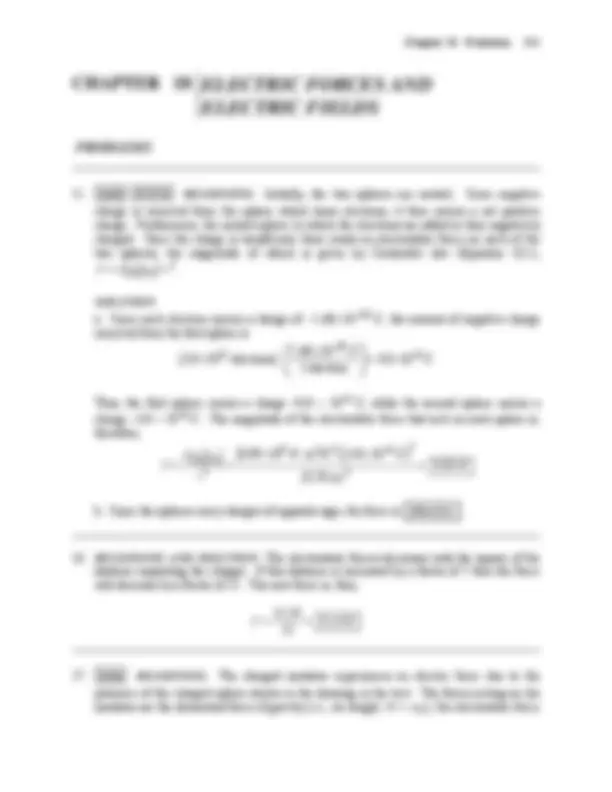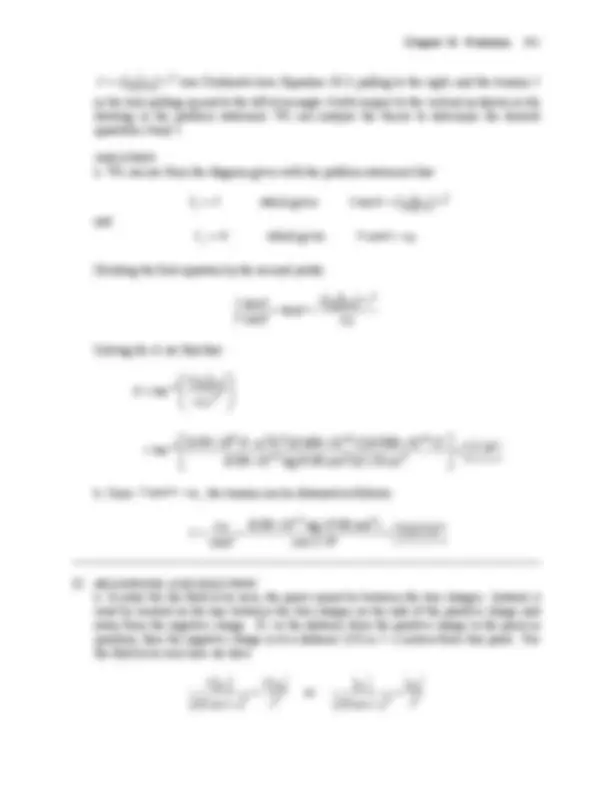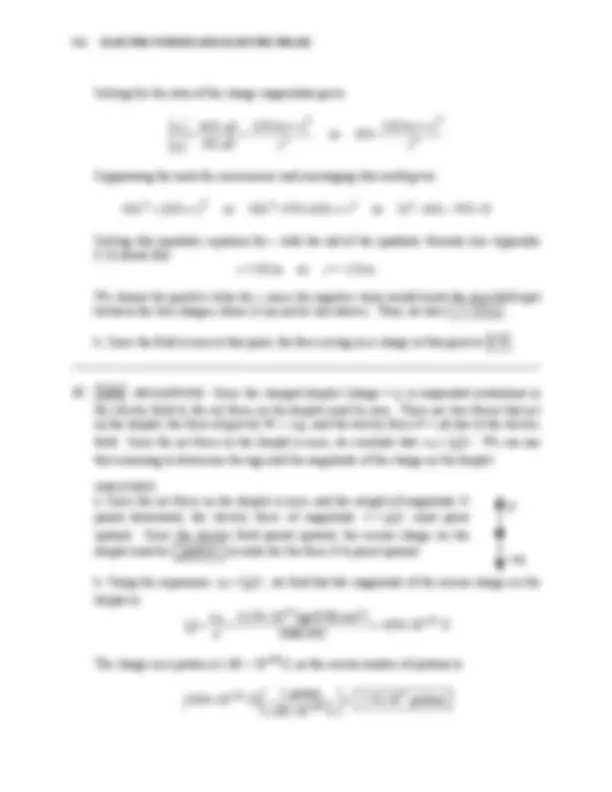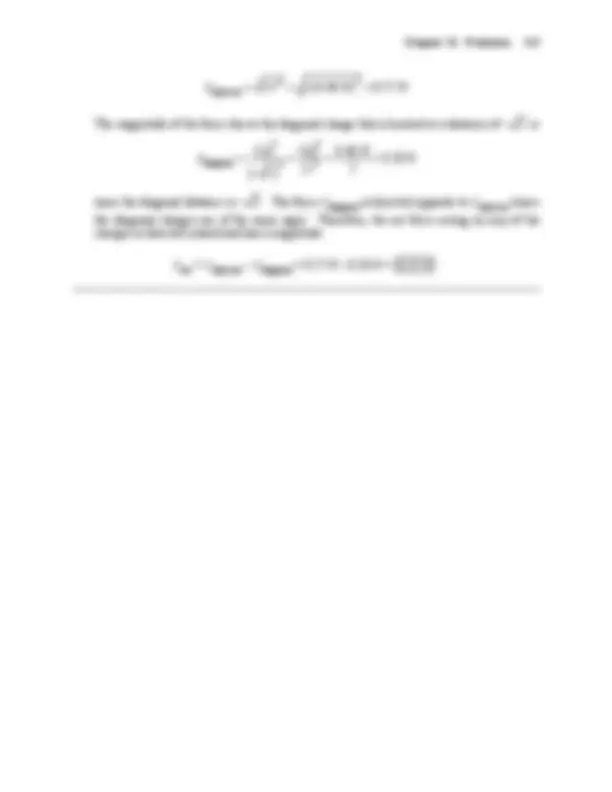






Study with the several resources on Docsity

Earn points by helping other students or get them with a premium plan


Prepare for your exams
Study with the several resources on Docsity

Earn points to download
Earn points by helping other students or get them with a premium plan
Community
Ask the community for help and clear up your study doubts
Discover the best universities in your country according to Docsity users
Free resources
Download our free guides on studying techniques, anxiety management strategies, and thesis advice from Docsity tutors
Answers to focus on concepts questions related to electric forces and electric fields. It covers topics such as coulomb's law, electric charges, electric fields, and the relationship between electric forces and electric fields.
Typology: Study notes
1 / 8

This page cannot be seen from the preview
Don't miss anything!





q q F k r
=. The force
is directed along the line between the charges and is an attraction for unlike charges and a repulsion for like charges. Charge B is attracted by charge A with a force of magnitude
2
q q k d
and repelled by charge C with a force of the same magnitude. Since both forces
point to the left, the net force acting on B has a magnitude of (^2 )
q q k d
. Charge A is attracted
by charge B with a force of (^2)
q q k d
and also by charge C with a force of ( )
2 2
q q k d
. Since both
forces point to the right, the net force acting on A has a magnitude of (^) (1.25 ) (^2)
q q k d
. Charge
C is pushed to the right by B with a force of (^2)
q q k d
and pulled to the left by A with a force
of ( )
2 2
q q k d
. Since these two forces have different directions, the net force acting on C has a
magnitude of (^) ( 0.75) (^2)
q q k d
Chapter 18 Answers to Focus on Concepts Questions 943
exerts on another point charge is given by (^2)
q q F k d
= , where d is the length of each side of
the triangle. The charge at B experiences a repulsive force from the charge at A and an attractive force from the charge at C. Both forces have vertical components, but one points in the + y direction and the other in the − y direction. These vertical components have equal magnitudes and cancel, leaving a resultant that is parallel to the x axis.
k q E r
= and is inversely
proportional to the square of the distance r. If r doubles, the charge magnitude must increase by a factor of 2^2 = 4 to keep the field the same.
Chapter 18 Problems 945
2 F = k q 1 (^) q 2 (^) / r (see Coulomb's law, Equation 18.1) pulling to the right, and the tension T
drawing in the problem statement. We can analyze the forces to determine the desired
a. We can see from the diagram given with the problem statement that
Tx = F which gives T sin θ = k q 1 (^) q 2 / r^2
g
and
Dividing the first equation by the second yields
2 sin (^) tan 1 2 / cos
T^ k q^ q^ r T m
θ θ θ
g
–1^1 2
9 2 2 –6 –
tan
(8.99 10 N m /C )(0.600 10 C)(0.900 10 C) tan 15. (8.00 10 kg)(9.80 m/s )(0.150 m)
k q q mgr
θ
(8.00 10 2 kg) (9.80 m/s )^2 0.813 N cos cos 15.
mg T
a. In order for the field to be zero, the point cannot be between the two charges. Instead, it must be located on the line between the two charges on the side of the positive charge and away from the negative charge. If x is the distance from the positive charge to the point in question, then the negative charge is at a distance (3.0 m + x ) meters from this point. For the field to be zero here we have
( ) ( )
3.0 m 2 2 or 3.0 m^2
k q k q q q x x^ x x^2
946 ELECTRIC FORCES AND ELECTRIC FIELDS
Solving for the ratio of the charge magnitudes gives
2 2 2 2
16.0 C 3.0 m^ 3.0 m or 4. 4.0 C
q (^) x x q (^) x x
Suppressing the units for convenience and rearranging this result gives
2 2 2 2 2 4.0 x = 3.0 + x or 4.0 x = 9.0 + 6.0 x + x or 3 x − 6.0 x − 9.0 = 0
Solving this quadratic equation for x with the aid of the quadratic formula (see Appendix C.4) shows that x = 3.0 m or x = −1.0 m
We choose the positive value for x , since the negative value would locate the zero-field spot between the two charges, where it can not be (see above). Thus, we have x = 3.0 m.
b. Since the field is zero at this point, the force acting on a charge at that point is 0 N.
the electric field E , the net force on the droplet must be zero. There are two forces that act on the droplet, the force of gravity W = m g , and the electric force F = q E due to the electric field. Since the net force on the droplet is zero, we conclude that mg = q E. We can use this reasoning to determine the sign and the magnitude of the charge on the droplet.
SOLUTION a. Since the net force on the droplet is zero, and the weight of magnitude W points downward, the electric force of magnitude F = q E must point upward. Since the electric field points upward, the excess charge on the droplet must be positive in order for the force F to point upward. m g
b. Using the expression mg = q E , we find that the magnitude of the excess charge on the droplet is –9 2 (3.50 10 kg)(9.80 m/s ) (^) 4.04 10 –12 C 8480 N/C
mg q E
The charge on a proton is 1.60 × 10 –19^ C, so the excess number of protons is
–12 7
1 proton 4.04 10 C 2.53 10 protons 1.60 10 C
948 ELECTRIC FORCES AND ELECTRIC FIELDS
b. Φ (^) E =
8.85 × 10 −^12 C 2 /(N ⋅ m 2 )
= –2.6 × 10 5 N ⋅ m 2 /C
c. Φ (^) E =
8.85 × 10 −^12 C 2 /(N ⋅ m 2 )
= 1.4 × 10 5 N ⋅ m 2 /C
ΦE = ( E cos φ) A = (150 N/C)(cos 35°)[(5.9 m)(2.5 m)] = 1.8 × 10 3 N ⋅ m 2 /C
no forces on each other. After the spheres are charged, each sphere experiences a repulsive force F due to the charge on the other sphere, according to Coulomb's law (Equation 18.1). Therefore, since each sphere has the same charge, the magnitude F of this force is
9 2 2 6 2 1 2 2 2
(8.99 10 N m /C )(1.60 10 C) 2.30 N (0.100 m)
k q q F r
The repulsive force on each sphere compresses the spring to which it is attached. The magnitude of this repulsive force is related to the amount of compression by Equation 10.1: F x Applied= kx. Setting Fx Appled^ = F and solving for k , we find that
2.30 N 92.0 N/m 0.0250 m
k x
( )( ) ( )
2 9 2 2 6 2 2 2
8.99 10 N m / C 2.0 10 C 0.40 N 0.30 m
k q F r
The forces due to two adjacent charges are perpendicular to one another and produce a resultant force that has a magnitude of
Chapter 18 Problems 949
( ) 2 2 F adjacent (^) = 2 F = 2 0.40 N =0.57 N
The magnitude of the force due to the diagonal charge that is located at a distance of r 2 is
( )
diagonal
2 2 2 2
k q k q F r r
since the diagonal distance is r 2. The force F diagonal is directed opposite to F adjacent (since the diagonal charges are of the same sign). Therefore, the net force acting on any of the charges is directed inward and has a magnitude
F net = F adjacent – F diagonal = 0.57 N – 0.20 N = 0.37 N